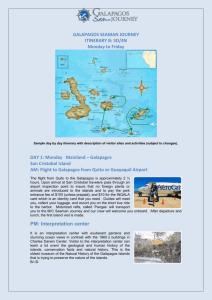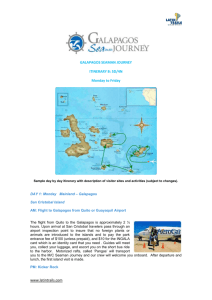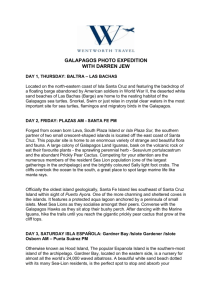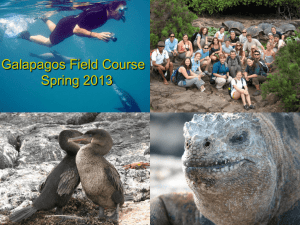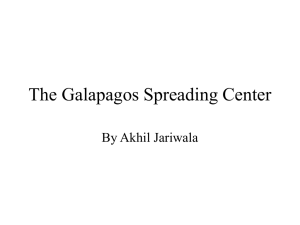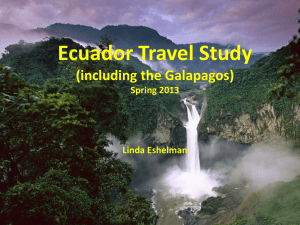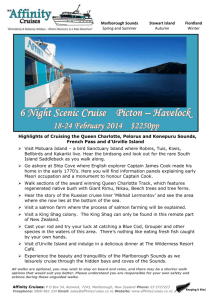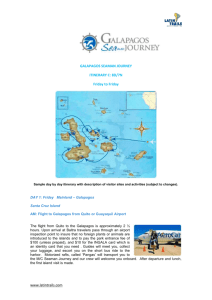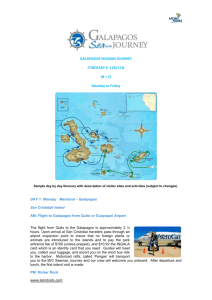Click here to
advertisement
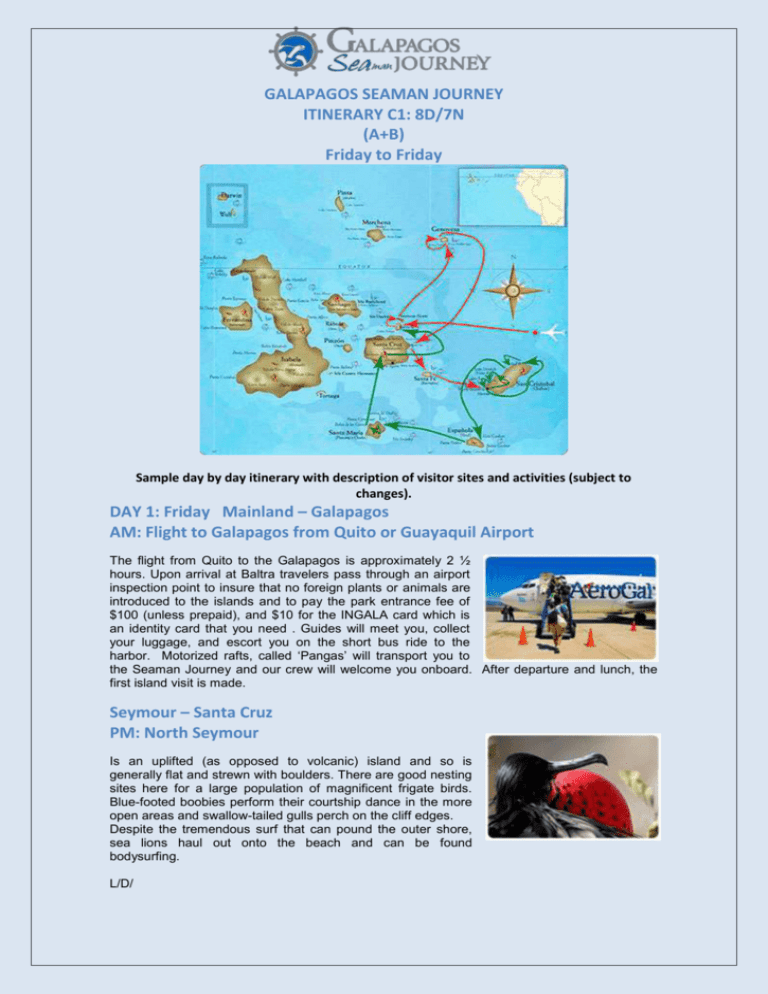
GALAPAGOS SEAMAN JOURNEY ITINERARY C1: 8D/7N (A+B) Friday to Friday Sample day by day itinerary with description of visitor sites and activities (subject to changes). DAY 1: Friday Mainland – Galapagos AM: Flight to Galapagos from Quito or Guayaquil Airport The flight from Quito to the Galapagos is approximately 2 ½ hours. Upon arrival at Baltra travelers pass through an airport inspection point to insure that no foreign plants or animals are introduced to the islands and to pay the park entrance fee of $100 (unless prepaid), and $10 for the INGALA card which is an identity card that you need . Guides will meet you, collect your luggage, and escort you on the short bus ride to the harbor. Motorized rafts, called ‘Pangas’ will transport you to the Seaman Journey and our crew will welcome you onboard. After departure and lunch, the first island visit is made. Seymour – Santa Cruz PM: North Seymour Is an uplifted (as opposed to volcanic) island and so is generally flat and strewn with boulders. There are good nesting sites here for a large population of magnificent frigate birds. Blue-footed boobies perform their courtship dance in the more open areas and swallow-tailed gulls perch on the cliff edges. Despite the tremendous surf that can pound the outer shore, sea lions haul out onto the beach and can be found bodysurfing. L/D/ DAY 2: Saturday Galapagos Cruise Genovesa Island AM: El Barranco The visitor site of El Barranco is located in the southern part of Darwin Bay on Genovesa Island. The trail is on volcanic rock that has a length of 1.5 km and the tour can be done in about 2 hours. The youngest area of the island, from a geological point of view, lies in this area. The cliffs located in the south are composed of very fragile lava. The natural erosion that has occurred in these lava flows has become the ideal place for nesting Storm Petrels. You can see two species of petrels that nest in cavities and holes in the lava. One of its main predators is the short-eared owl. The redfooted booby nests only in the outer islands of the archipelago, Punta Pitt, Gardner (Floreana), Wolf, Darwin and Genovesa. Also present on this island is the masked booby. During the “panga rides” along the cliffs fur sea lions can be seen and several species of seabirds. PM: Darwin Bay This bay has its origin when the crater of this island collapsed below sea level. The wet landing is on a beautiful white coral sandy beach. This is a favorite island for birdwatchers: red footed-booby, masked boobies, wandering tattlers, lava gulls, whimbrels, yellow-crowned, and black-crowned lava herons, and yellow warblers can be seen in the area. Continuing on the trail, visitors climb gradually to the edge of the cliff seeing Red-Foots nesting in the Mangrove trees below. Bird watching includes sightings of sharp-beaked finches, large cactus and ground finches, Galapagos doves, and swallow-tailed gulls. Reaching the end the trail at the cliff's edge offers an incredible view of the island and the many birds living there. B/L/D DAY 3: Sunday Galapagos Cruise Santa Cruz Island / Santa Fe Island AM: Plazas Plazas is located at the east of Santa Cruz Island, and forms part of two islands known as Islas Plazas. Despite its small size, some of the most interesting and outstanding species of the Galapagos are found here. The Plazas land iguanas are smaller than its relatives found at other islands. Throughout the island are several hybrid iguanas, a result of crossing a male marine iguana and a female land iguana, they are unique, recognizable at first glance by their black/gray color, with a land iguana's crest, but face and tail of the marine iguana. The big population of iguanas is due to the presence of tunas, their favorite food. Swallow tailed gulls nesting in the rugged cliffs are seen along with other sea birds as: Audubon shearwaters, red-billed tropicbirds, frigate birds, and brown pelicans. PM: Santa Fe Located in the southeastern part of the Galapagos, this island was formed from an uplift instead than a volcanic origin, this is why is mostly flat. There are some theories which assure this could be the oldest island in the Archipelago. Santa Fe is the home of a number of endemic species like the Galapagos hawk, Galapagos snake, Galapagos mockingbird, rice rats, and one of the two species of lands Iguanas of the islands. After disembarking in the beautiful and clear waters you will be in contact with one of the many sea lion colonies. Along the trail many salt bushes can be seen as well giant Pickly pear cactus, gigantism is a characteristic of oceanic islands. There are great possibilities of snorkeling with playful sea lions and tropical fishes. B/L/D DAY 4:Monday Galapagos Cruise San Cristobal Island AM: Jacinto Gordillo Breeding Center. In 2004 the Breeding and Rearing Center for young tortoises Jacinto Gordillo, named after a famous settler, was located in Cerro Colorado, San Cristobal Island, in order to take care of young tortoises. In 2008 an assisted reproduction program started on the island with due to the birth of a little turtle in captivity. PM: Interpretation center It is an interpretation center with exuberant gardens and stunning ocean views in contrast with the 1960´s buildings in Charles Darwin Center. Visitor to the interpretation center can learn a lot ovenr the geological and human history of the islands, conservation facts and natural history. This is the oldest museum of the Natural History of the Galapagos Islands that is trying to preserve the nature of the islands. B/L/D DAY 5: Tuesday Galapagos Cruise San Cristobal Island AM: Galapaguera A short visit to the natural Galapaguera that is a good place to observe Galapagos tortoises in its natural habitat. PM: Cerro Brujo Cerro Brujo is a beautiful beach of white coral beach where you can swim and watch birds and sea lions, plus you can snorkel. This is the first coast where Charles Darwin walked in 1835. In this marvelous lava landscape where you can see seabirds like blue-footed boobies, Nazca boobies, herons, frigate birds and shore birds. The protected bay is very popular to observe young tortoises and for swimming. The pools with salty water behind the sand dunes were used for the fishers as a salt mine in order to preserve food for the local population. Among the fauna that you can observe the Chatham Mockingbird and the San Cristobal Lava Lizard, both species are endemic to the island and unique to the area as they cannot be observed nowhere else. Also you can find the island canary, the Galapagos turtles and with luck the little bird known as the Pájaro Brujo in Spanish, an endemic specie from San Cristobal Island. The vegetation covers all the route where you can find species like the candelabrum cactus and carob trees. Located on the north coast of Isla San Cristobal it is a peaceful place with white sand and crystal water, a perfect combination for an incredible stay. B/L/D DAY 6: Wednesday Galapagos Cruise Española Island AM: Gardner Bay Located on the north-eastern coast of Hood, Gardner Bay provides an excellent beach for relaxing, swimming, snorkeling, kayaking, and the opportunity to observe sea lions. Here we can also observe sharks in the crystal clear ocean waters. PM: Suarez Point This area is great for spotting blue-footed boobies, albatrosses and Nazca boobies. A beautiful site on the ocean front, the large waved albatrosses use the cliff as a launching pad. The famous attraction is the magnificent blowhole, spurting water high into the air at least from 50 to 75 meters high. This site presents wonderful photograph opportunities. B/L/D DAY 7: Thursday Galapagos Cruise Floreana Island AM: Cormorant Point This site offers probably the best flamingo lagoon in the Galapagos; it is also one of the largest in the islands. It’s situated between two tuff lava cones that give the area a special atmosphere. There are various species of shorebirds to observe besides flamingos; the most frequent are common stilts, white-checked pintail ducks, and other migratory birds. It is very interesting to see the two distinct beaches: “The Green Beach” (due to its high percentage of olivine crystals in the sand) and the “Flour Sand Beach” which is made up of coral. PM: Post office bay & Baroness Lookout Historically, this site is the location of a wooden barrel that was placed in the 18th century by the crew of a whaling ship. It has been used since this time by mariners and tourists as a post office. The idea is to carry letters or postcards to their destination by hand. Apart from being the Post Office Barrel, this site was the landing area for some of the first colonists. We will continue to the north of the island and will ascent to an elevated slope to enjoy a beautiful vista at the Baroness lookout. It is said that Baroness Eloisa Von Wagner loved this place and spent several hours watching the horizon. Within walking distance (30 m) are the ruins of what is known as her house. From this lookout, the landscape covers the coastline from the Enderby islet to Post Office Bay, as well as Cerro Pajas, the pool of flamingos and wide forest of Palo Santo. B/L/D DAY 8: Friday Galapagos Cruise Santa Cruz Island AM: Charles Darwin Station Although the great majority of Galapagos visitors come here to observe and appreciate natural wonders, it is also interesting to learn how the protection and conservation of the islands are carried out. One of the main attractions are the National Park information center, the Van Straelen Exhibition Hall, the Breeding and Rearing Center for young tortoises, Lonesome George (turtle from Pinta), and adult Galapagos tortoises in captivity. B/-/After the morning excursion you will be taken to the airport for your flight to the mainland Transfer to Baltra airport Flight to Quito or Guayaquil

